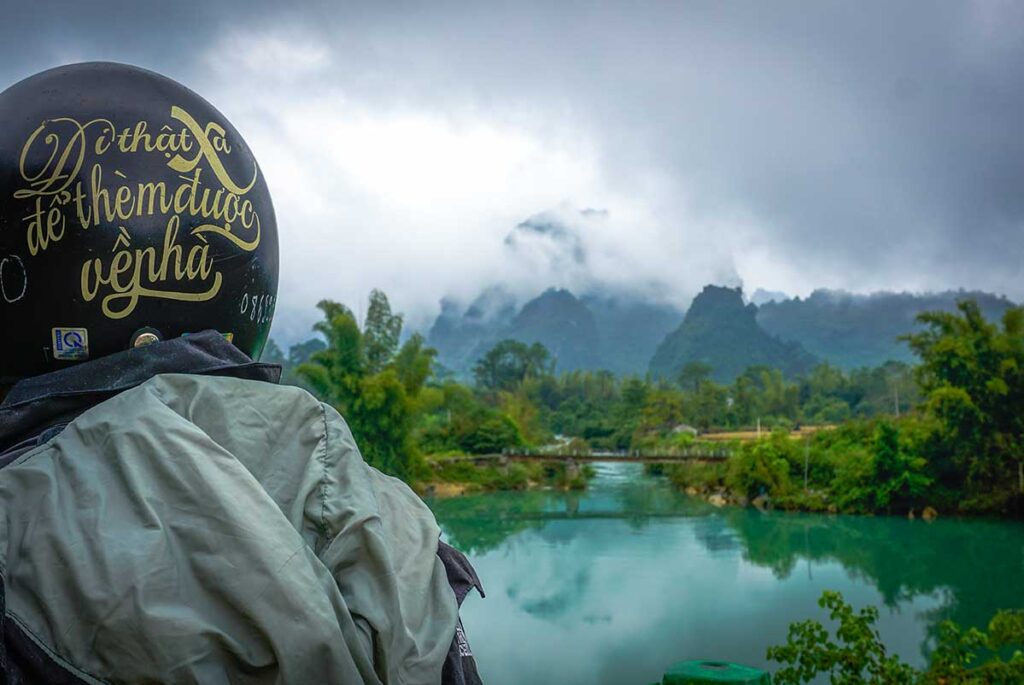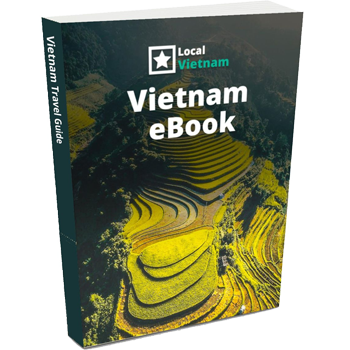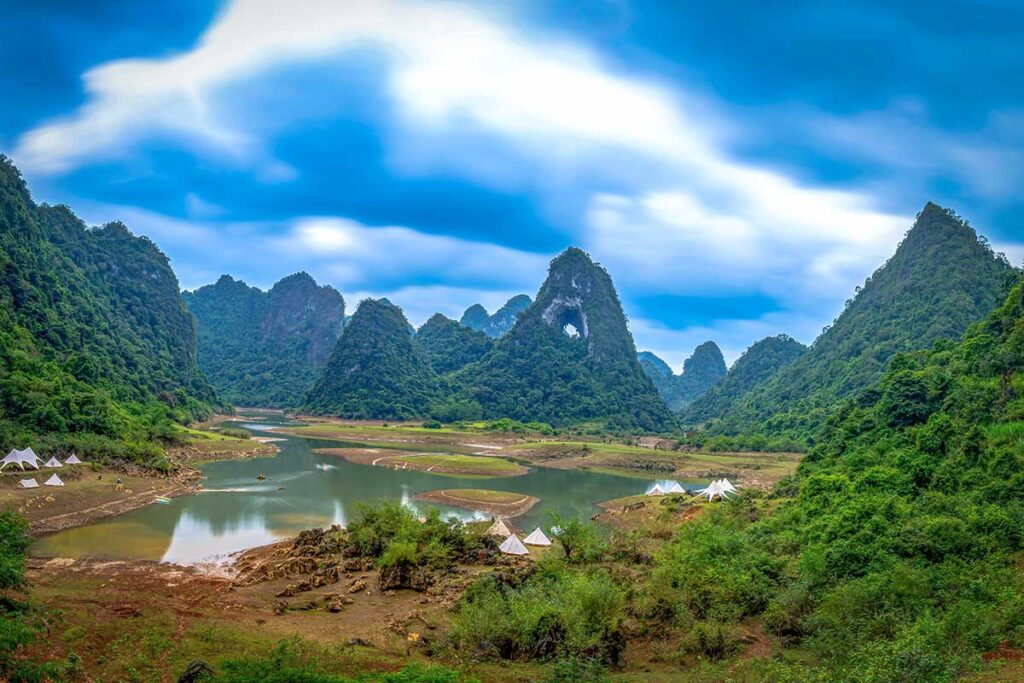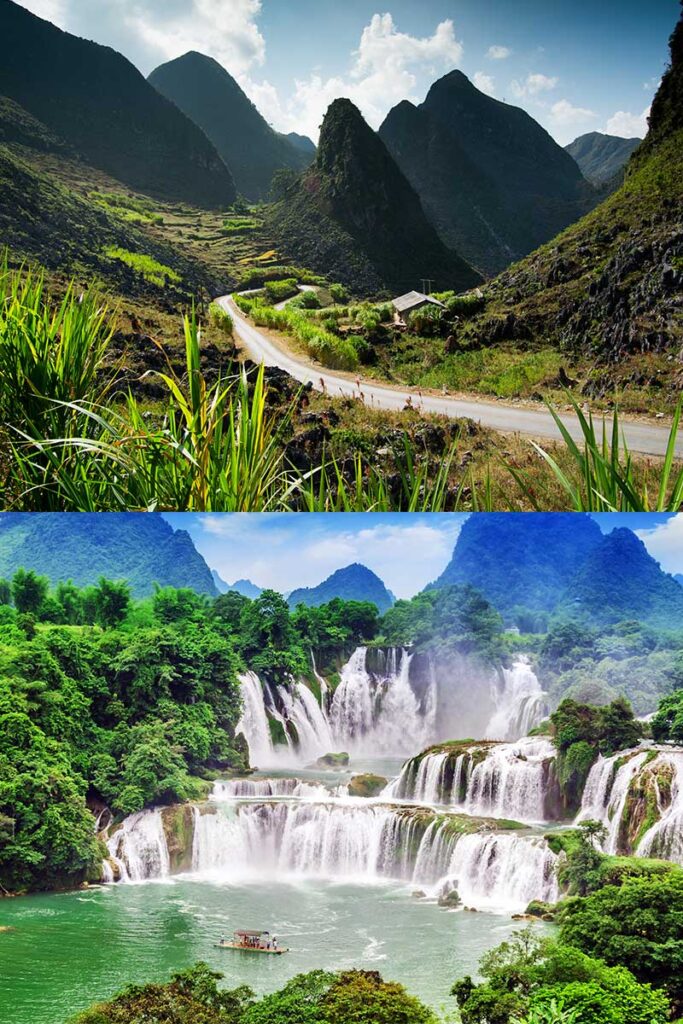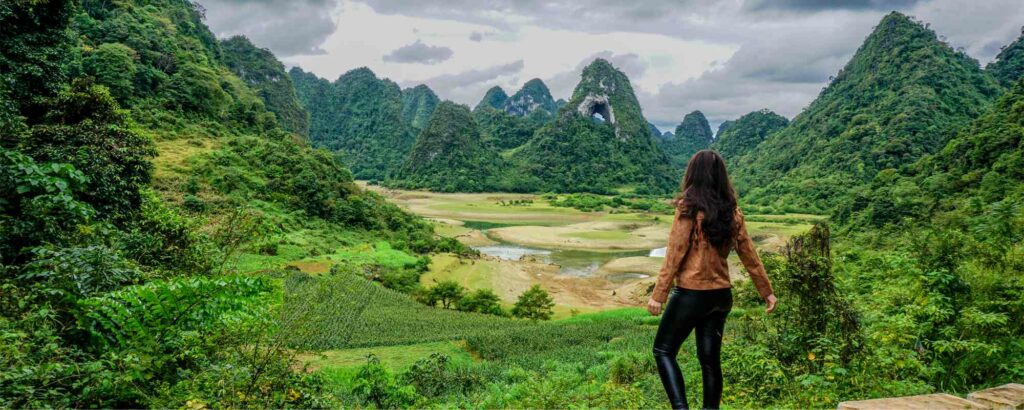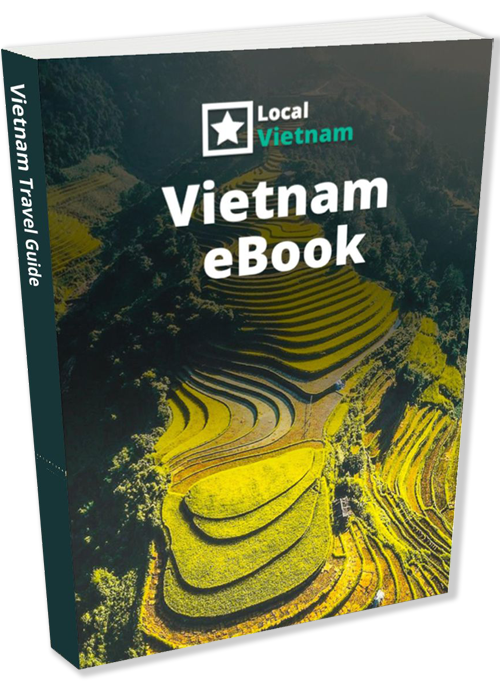What is the Cao Bang Loop?
The Cao Bang Loop is a scenic route through Cao Bang province, located in northern Vietnam along the border with China. The province is known for its remote landscapes, but few travelers explore beyond the famous Ban Gioc Waterfall.
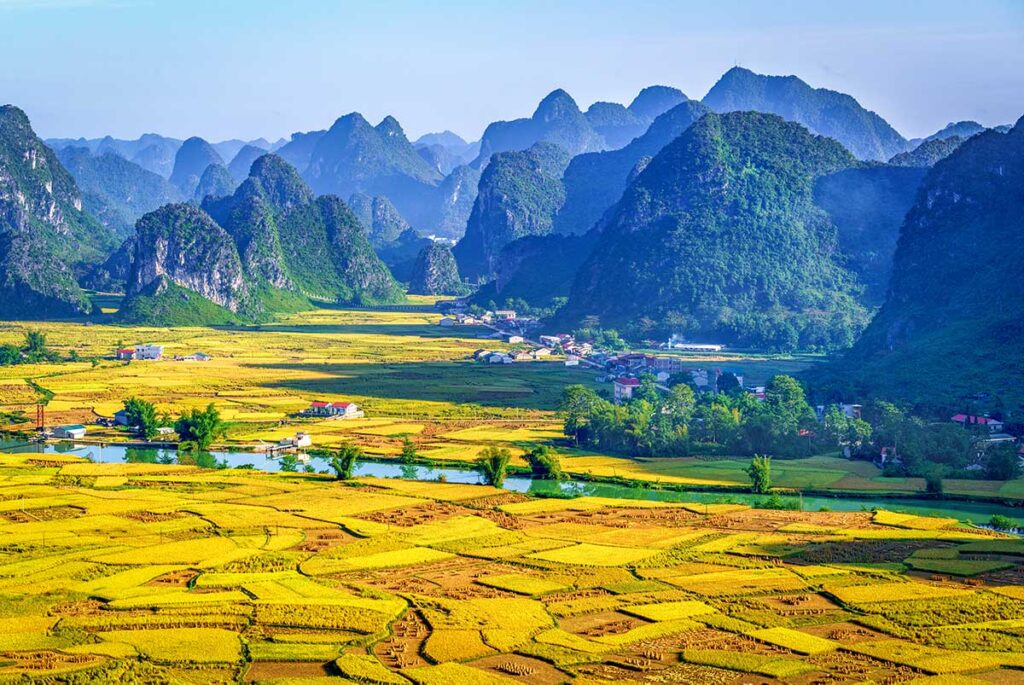
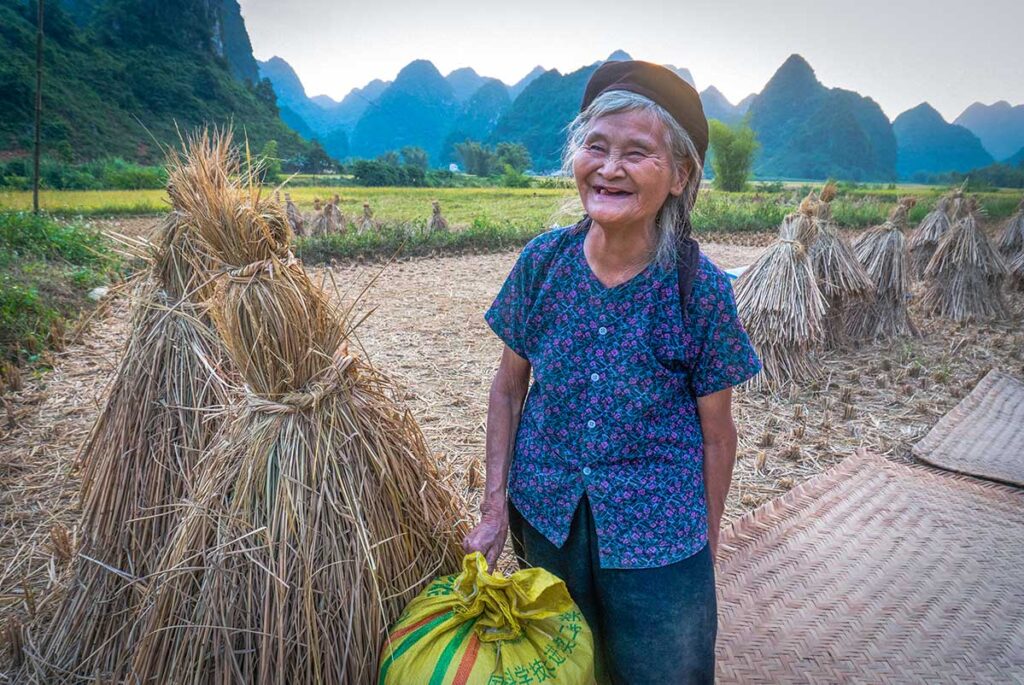
To help visitors discover more of the region’s beauty, a loop was created that connects its most impressive natural sights and remote local villages. Along the way, you’ll find towering waterfalls, mountain scenery, hidden rice valleys, and a glimpse into the daily life of ethnic minority communities. It’s one of the best places in Vietnam to go off the beaten track.
Often compared to the Ha Giang Loop, Cao Bang offers a similar mix of nature and culture — but with far fewer tourists and a more peaceful atmosphere. You can do a short version of the loop in 2–3 days, focusing on highlights like Ban Gioc and Angel Eye Mountain, or extend it to 4–6 days to reach the far east and west corners of the province, including places like Bao Lac, the Me Pia Pass, and the quiet hills around Vinh Quý.
Cao Bang Loop vs Ha Giang Loop
As mentioned earlier, the Cao Bang Loop is often seen as an alternative to the better-known Ha Giang Loop — but which one is better?
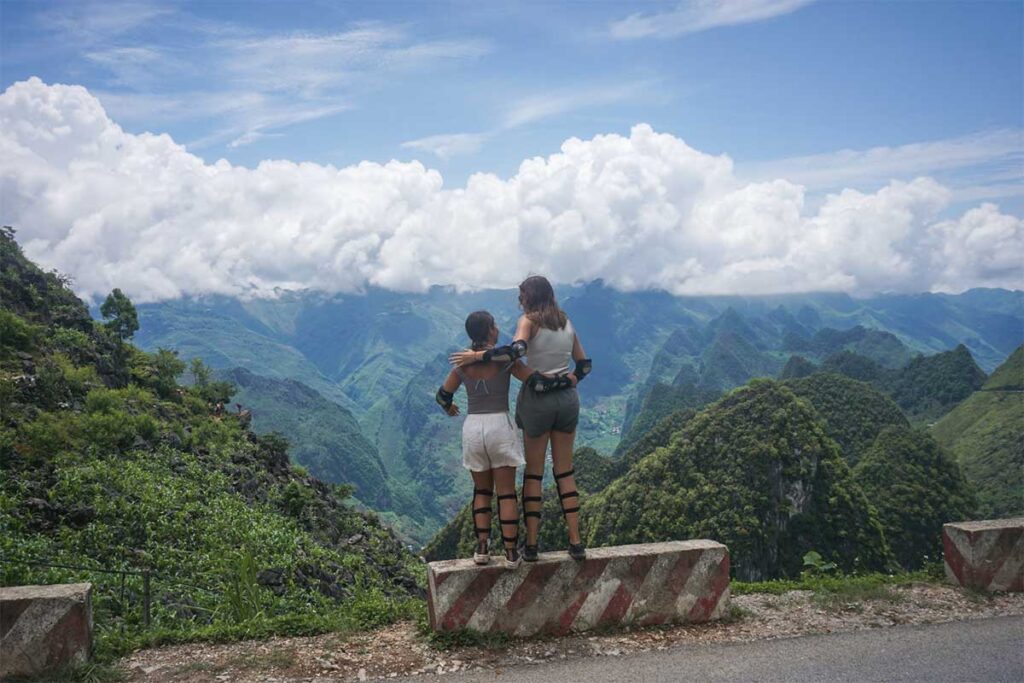
Ha Giang is famous for its wild, dramatic mountain landscapes, especially along the Ma Pi Leng Pass, and it’s home to some of Vietnam’s largest ethnic minority communities and colorful highland markets. The scenery is raw, steep, and rugged — perfect if you’re looking for Vietnam’s most extreme mountain roads.
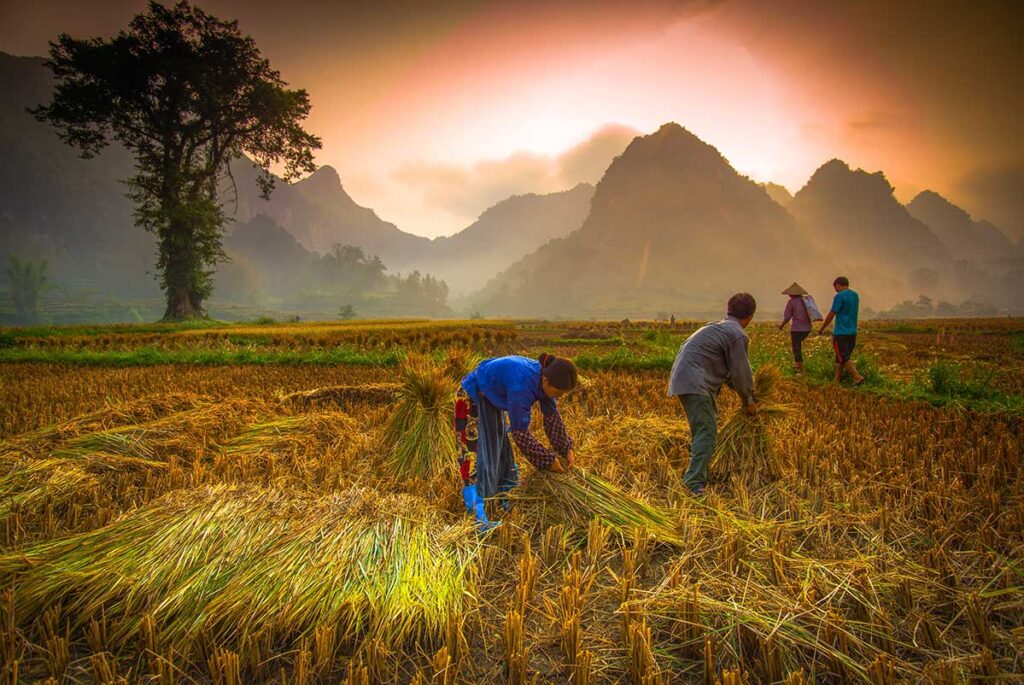
Cao Bang, on the other hand, offers a different kind of beauty. The landscapes, particularly around Ban Gioc Waterfall and Phong Nam Valley, are more valley-based, with wide open views of rice fields surrounded by karst mountains — somewhat similar to Ninh Binh, but much larger and more untouched. While Ha Giang has become a popular route with lots of visitors in recent years, Cao Bang remains much quieter. Even areas just minutes away from Ban Gioc often feel completely undiscovered, with peaceful roads and friendly ethnic locals living far from the tourist path.
If you’re looking for raw mountain adventure, Ha Giang may still be the top choice. But for those who prefer more peaceful, hidden landscapes and fewer tourists, Cao Bang is hard to beat.
Tip: Combining Ha Giang and Cao Bang
Why not get the best of both worlds?
Ha Giang and Cao Bang are located right next to each other in northeast Vietnam, and it’s very possible to combine them into a single trip. You won’t drive the full loop in both provinces, but you will visit the most iconic highlights of each.
Think of riding the legendary Ma Pi Leng Pass, exploring Dong Van Old Town, and visiting ethnic markets in Ha Giang — followed by the peaceful valleys, Ban Gioc Waterfall, and less-touristed spots like Phong Nam, Bao Lac, and Angel Eye Mountain in Cao Bang. If you have 4–7 days, this could easily be one of the most epic road trips in Vietnam.
Ha Giang – Cao Bang & Ban Gioc Waterfall – Ba Be Lake in 5 Days
- Experience: Ha Giang Loop, Ban Gioc Waterfall, and Ba Be Lake in one seamless trip.
- Includes: All transfers from Hanoi, local guide, meals, and accommodations, getting around by car or motorbike
Where to start and how to get there?
Cao Bang City
The Cao Bang Loop starts and ends in Cao Bang City, which shares the same name as the province. This small city is your base before and after completing the loop. It’s located about 280 km (175 miles) from Hanoi, and the only way to reach it is by road — no trains or flights. The drive takes at least 6 hours, and there are two main routes: one via Thai Nguyen, the other through Lang Son.
Getting there
Option 1: Sleeper night buses
If you’re short on time, a sleeper night bus from Hanoi to Cao Bang can be a smart choice. Buses usually leave late in the evening and arrive in Cao Bang very early in the morning, often between 2:00 and 5:00 AM, depending on the company and departure time.
This saves you a full day of travel and gives you more time for exploring. The downside? Sleeper buses aren’t for everyone — some travelers find it difficult to sleep, and others don’t feel entirely comfortable traveling overnight. If you arrive too early, you can always book a cheap hotel or guesthouse for a few hours of rest before starting the loop.
Option 2: Limousine day bus
If you prefer traveling during the day, limousine buses are a more comfortable and modern option. These mini-vans are smaller than regular buses, often have reclining leather seats, and include Wi-Fi and air-conditioning. The journey usually takes 6–7 hours, with departure times throughout the morning and early afternoon.
It’s a great choice if you want to travel in comfort and see the landscape during the ride, but it does take up a full day of your itinerary.
Other options explained
- Private car with driver:
Ideal for groups, families, or those who want maximum flexibility. A private transfer from Hanoi to Cao Bang can be arranged. It’s more expensive, but allows for custom stops along the way and a more relaxed schedule.
- From Ha Giang:
There is a public bus service from Ha Giang to Cao Bang, but if you’re already doing the Ha Giang Loop, it makes more sense to continue east and connect the two loops by motorbike or car. That way, you avoid backtracking and get to explore more of the remote northeast.
- From other destinations in Vietnam:
There are no direct buses or trains to Cao Bang from most other tourist spots like Sapa, Ninh Binh, or Halong Bay. You’ll need to travel back to Hanoi first, then continue to Cao Bang by bus or private car. Alternatively, you can book a custom transfer, but this is typically only arranged through private tour services.
How to drive the Cao Bang Loop?
Option 1: Motorbike (selfdrive)

Riding a motorbike through Cao Bang gives you a real sense of freedom and adventure. The landscapes along the loop are stunning, and with limited traffic in this part of Vietnam, the ride itself becomes a major highlight.
That said, self-driving through the mountains isn’t for beginners. Even though roads are generally quiet, they can be steep, winding, and remote. You should have solid motorbike experience, especially on mountain roads.
Legally, you’ll also need a valid motorbike license from your home country plus an International Driving Permit (IDP) to drive in Vietnam. Most rental shops won’t check this, and you’ll rarely see police on the road — but in case of an accident, your travel insurance may not cover you without the proper documents.
Option 2: Easy Rider (on the back of a motorbike)
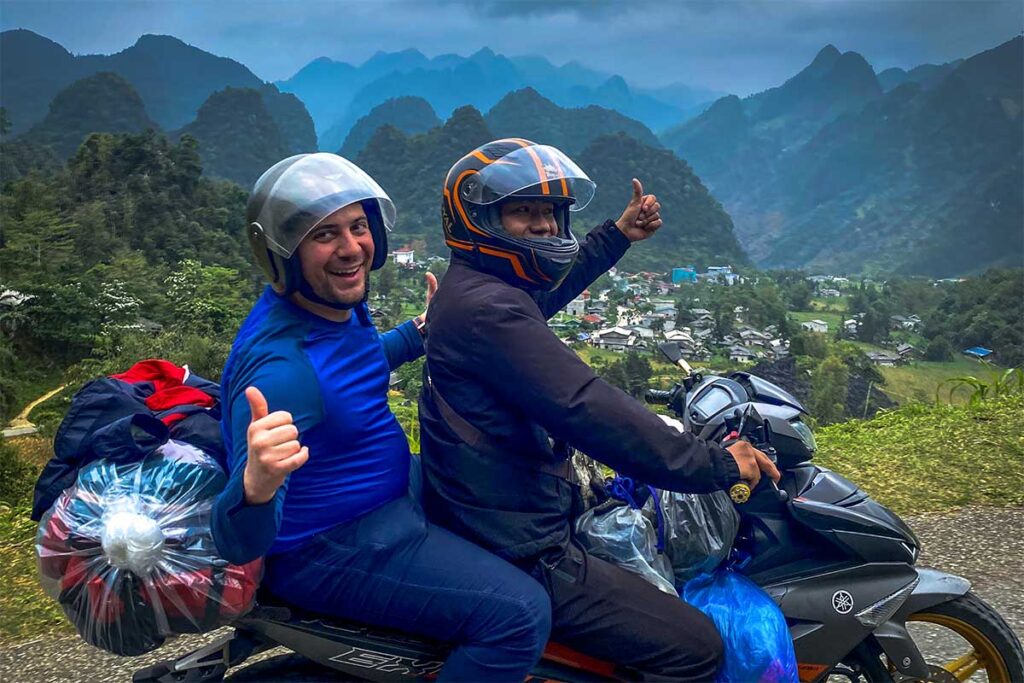
If you want the motorbike experience without the stress of driving, going with an Easy Rider guide is a great choice. You ride on the back of the motorbike with an experienced local driver who knows the roads, the culture, and the best hidden spots.
This option is not only safer, but also more relaxing. There’s no need to navigate or worry about road conditions — and you’ll often learn more about the region through your guide, who acts as both driver and storyteller along the way.
Tip: Or book a tour with transfers included
All our Ha Giang Loop tours include transfers from Hanoi, with options to start from Sapa or Cao Bang. It’s the easiest way to get there and explore stress-free. See all available tour options here.
Option 3: Car (including driver)
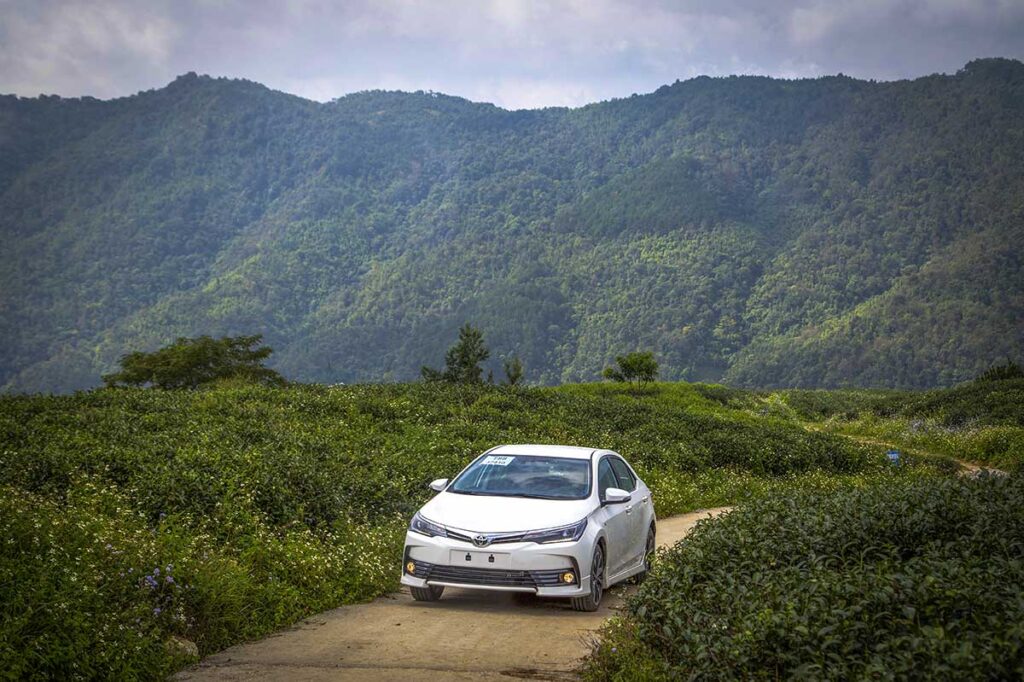
Exploring the Cao Bang Loop by private car with a driver follows pretty much the same route as the motorbikes, with only a few small detours where narrow paths aren’t suitable for vehicles. You’ll still reach all the major highlights described later in this guide.
The biggest advantage is comfort — especially over several days. A car offers protection from weather (cold, heat, rain, wind), better seating, and more space for luggage. It’s ideal for families, small groups, or travelers who prefer a more relaxed experience.
The trade-off is that it feels less adventurous compared to motorbiking. You’ll miss the open-road feeling, but for many travelers, the added comfort and convenience are well worth it.
Tip: Or book a tour with transfers included
All our Ha Giang Loop tours include transfers from Hanoi, with options to start from Sapa or Cao Bang. It’s the easiest way to get there and explore stress-free. See all available tour options here.
Route of the Cao Bang Loop
The Cao Bang Loop isn’t one fixed route. Unlike the Ha Giang Loop, where most travelers follow the same circular path, Cao Bang gives you more flexibility. It’s made up of a base route — which includes the province’s most famous highlights — and optional eastern and western extensions that turn it into a full loop.
Depending on how much time you have and how far off the beaten track you want to go, you can keep it simple or build a longer and more remote adventure.
Base of the Cao Bang Loop (2 to 3 Days)
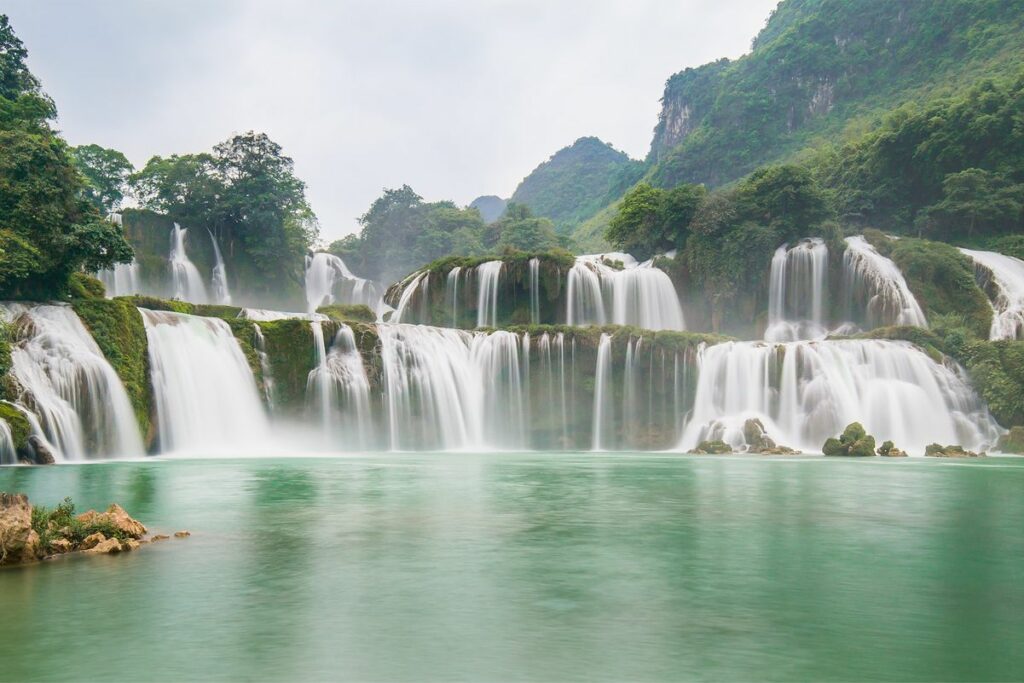
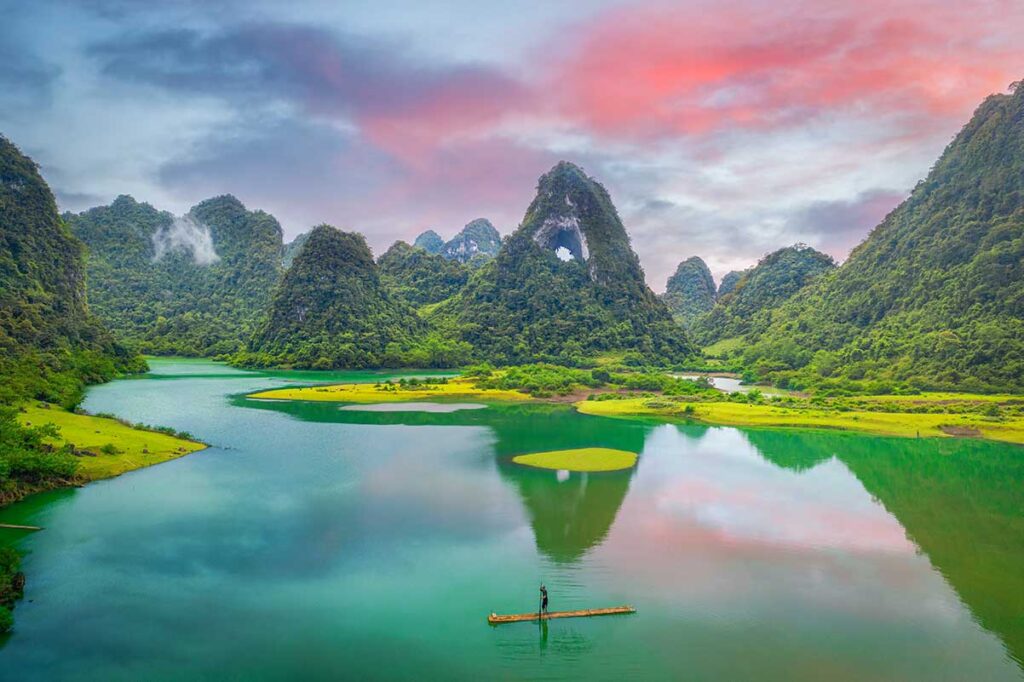
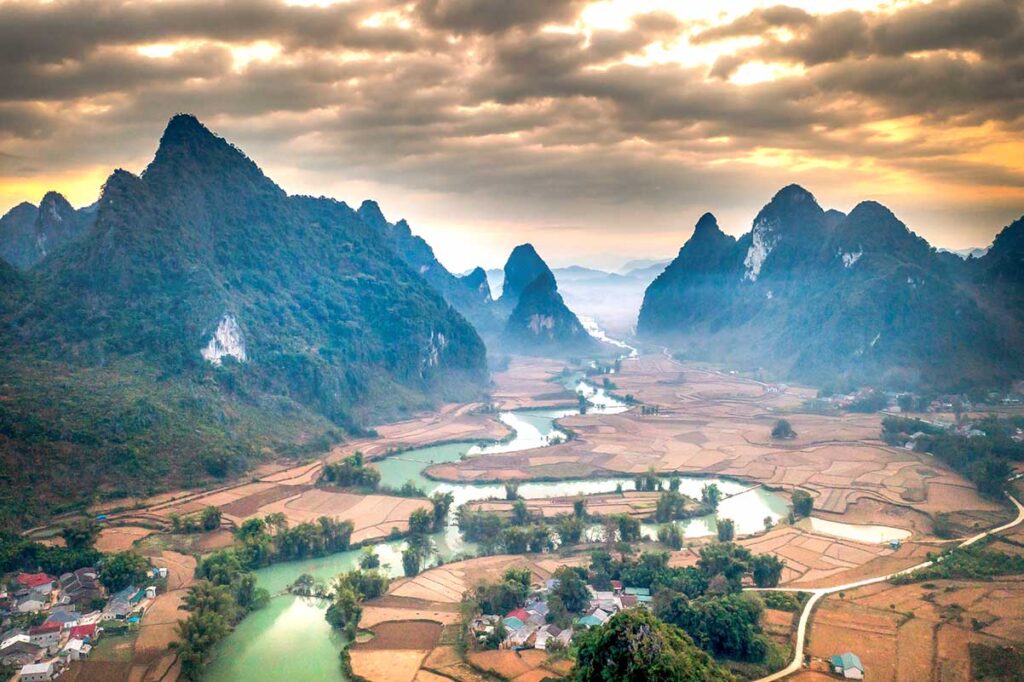

This is the core section of the Cao Bang Loop — the part most travelers follow to visit the province’s main attractions. It includes incredible sights like Ban Gioc Waterfall, Nguom Ngao Cave, Phong Nam Valley, and Angel Eye Mountain.
You start and end in Cao Bang City, but the route is not a true loop — you’ll drive to Ban Gioc and back mostly along the same road. Still, this stretch covers many of the most spectacular landscapes in northern Vietnam and makes for a rewarding short trip on its own.
To turn this route into a full loop, you can add the eastern extension, the western extension, or both.
- Day 1: Cao Bang City -> Ma Phuc Pass -> Angel Eye Mountain -> Thang Hen Lake -> Trung Khanh
- Day 2: Trung Khanh -> Ban Gioc Waterfall -> Phat Tich Truc Lam Ban Gioc Pagoda -> Nguom Ngao Cave -> Phong Nam Valley -> Trung Khanh
- Day 3: Trung Khanh -> Cao Bang City
Cao Bang Eastern Loop extension (+1 day)
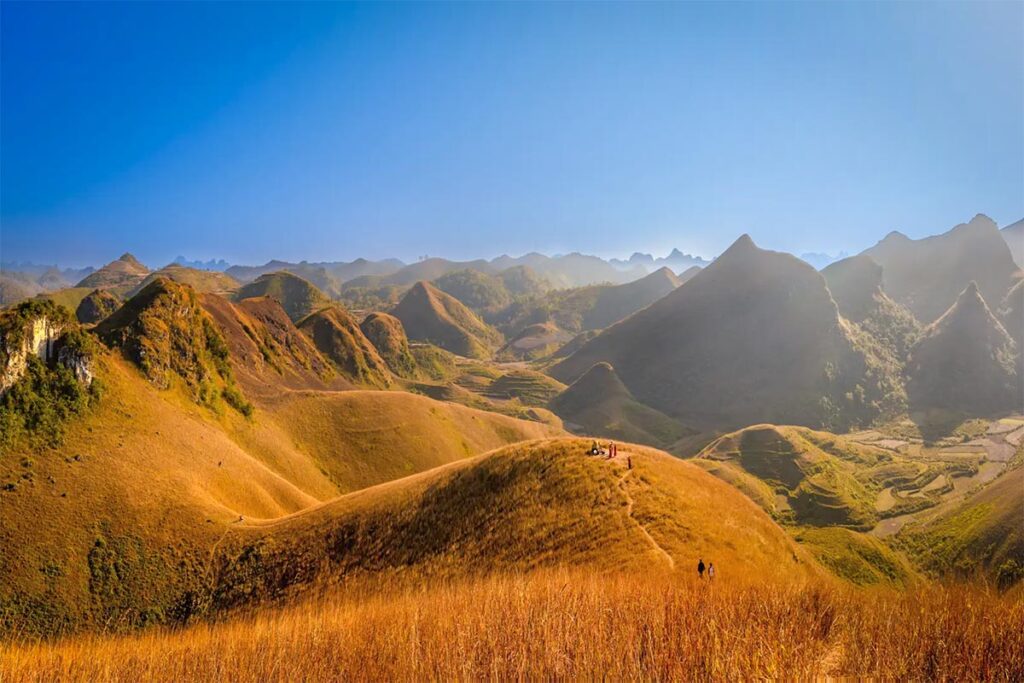
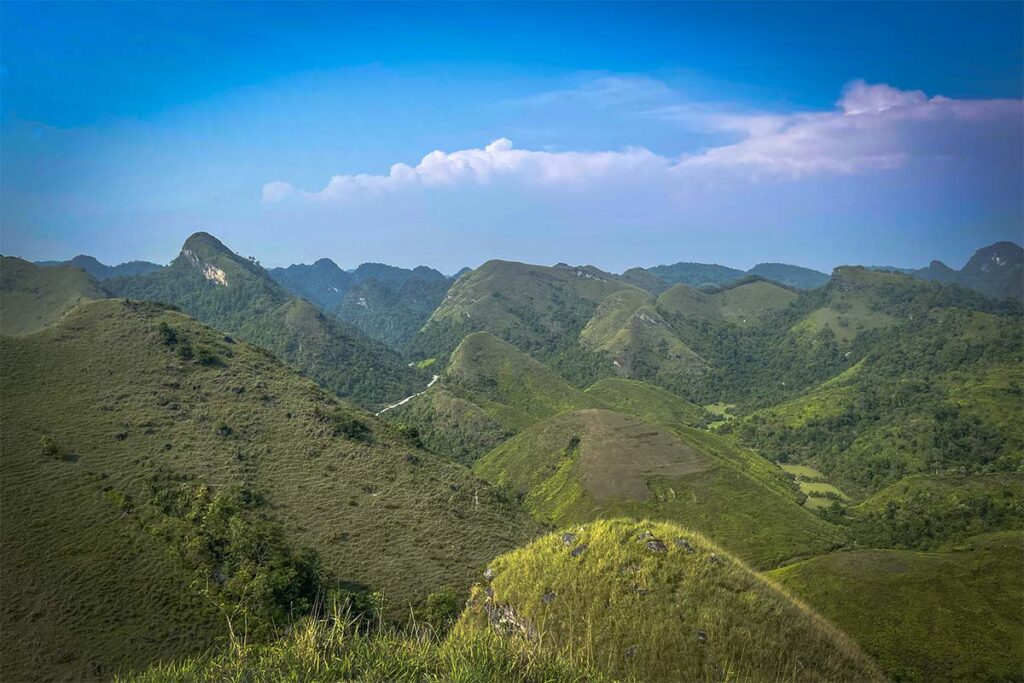
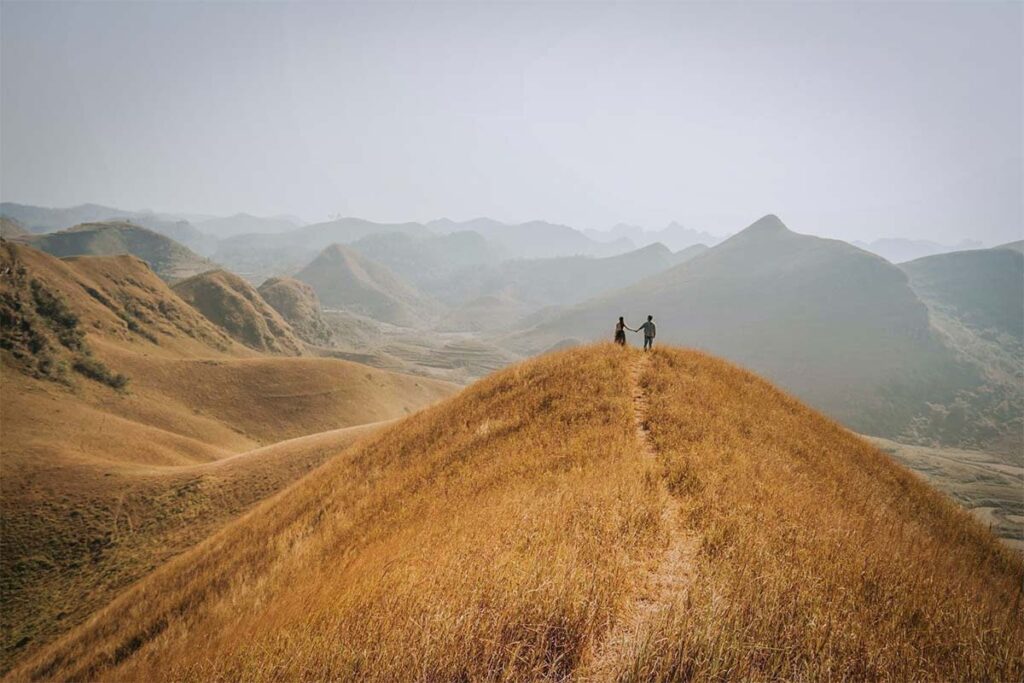
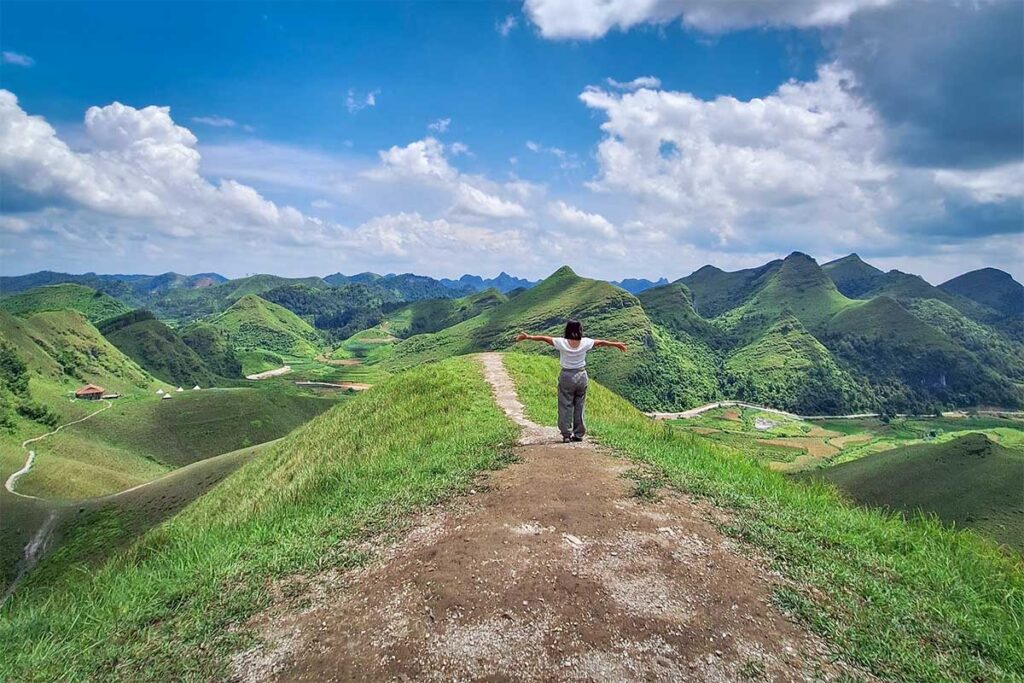
The eastern extension allows you to return to Cao Bang City via a more remote and lesser-known route, turning the basic itinerary into a true loop. This area sees very few tourists, with quiet roads, small villages, and peaceful rural scenery.
It’s a great way to add a deeper and more authentic travel experience without adding too much time.
- + 1 Day: Trung Khanh -> Ha Lang District (Vinh Quy grass hills) -> Cao Bang City
Cao Bang Western Loop extension (+2 to 3 days)
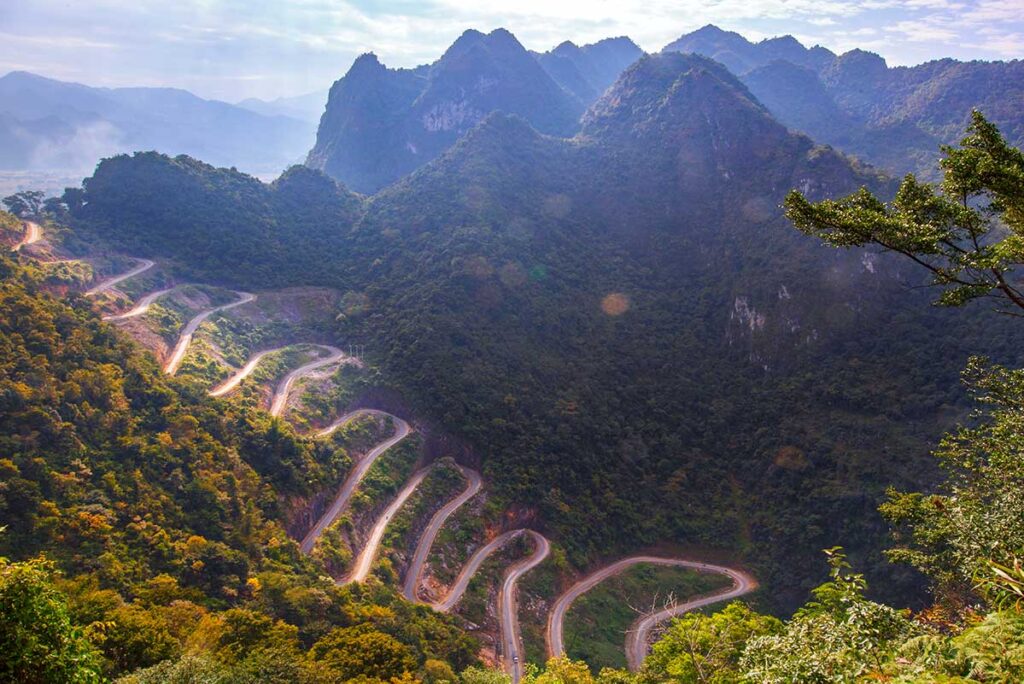
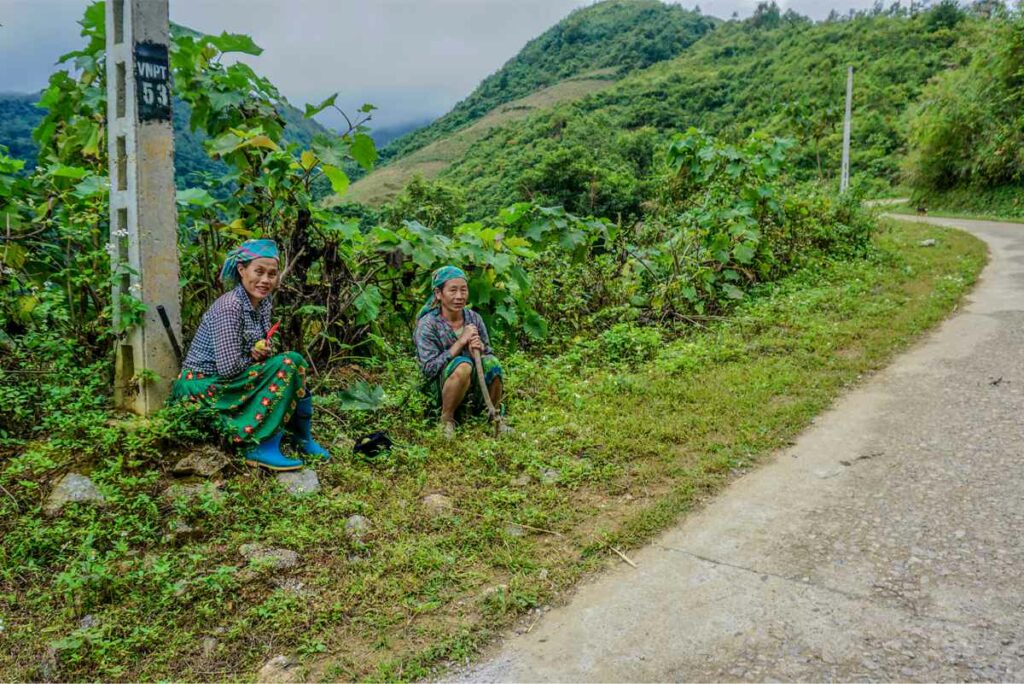

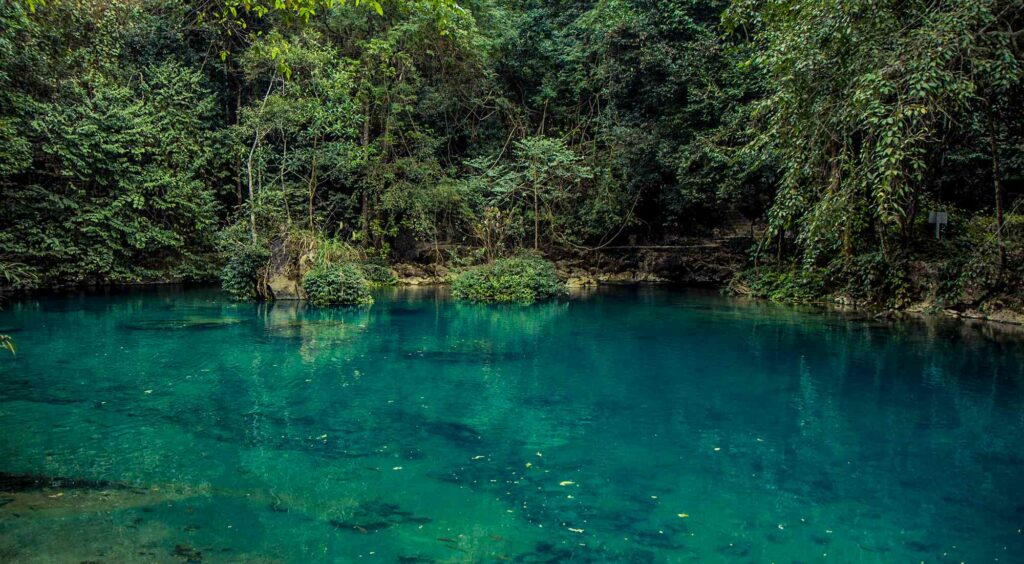
The western extension takes you all the way to Bao Lac District, near the border with Ha Giang province. It’s the most remote and wild section of the Cao Bang Loop and adds a completely different atmosphere to your trip.
There are two main ways to access this area:
- A northern route through Pac Bo, close to the Chinese border
- A southern route passing through Phja Oac National Park, with mountain views and cooler weather
The most complete version of the Cao Bang Loop combines both extensions — traveling from Ban Gioc across the north, into the west, and looping back via the southern route to Cao Bang City.
- + 1 Day: Trung Khanh -> Pac Bo -> Me Pia Pass -> Bao Lac
- + 2 Day: Bao Lac -> Phja Oac National Park-> Cao Bang City
Highlights along the Cao Bang Loop
The Cao Bang Loop is full of impressive places to visit — from famous landmarks to quiet valleys with no tourists in sight. Below is a list of the best things to see and do along the route.
These highlights are listed roughly in the order you might encounter them while traveling the loop, not ranked by importance. Also keep in mind — some of the biggest highlights are not individual sights, but the journey itself: remote mountain roads, peaceful ethnic villages, and stunning scenery everywhere in between.
Highlights along the basic Cao Bang Loop route
This section covers the main sights that most travelers visit — the core part of the Cao Bang Loop.
1. Cao Bang City
Cao Bang City is the starting and ending point of the loop. It’s a small, relaxed city with local restaurants and markets, but there aren’t many sights to visit. Don’t plan too much time here — it’s mainly a base to begin or end your journey.
2. Ma Phuc Pass
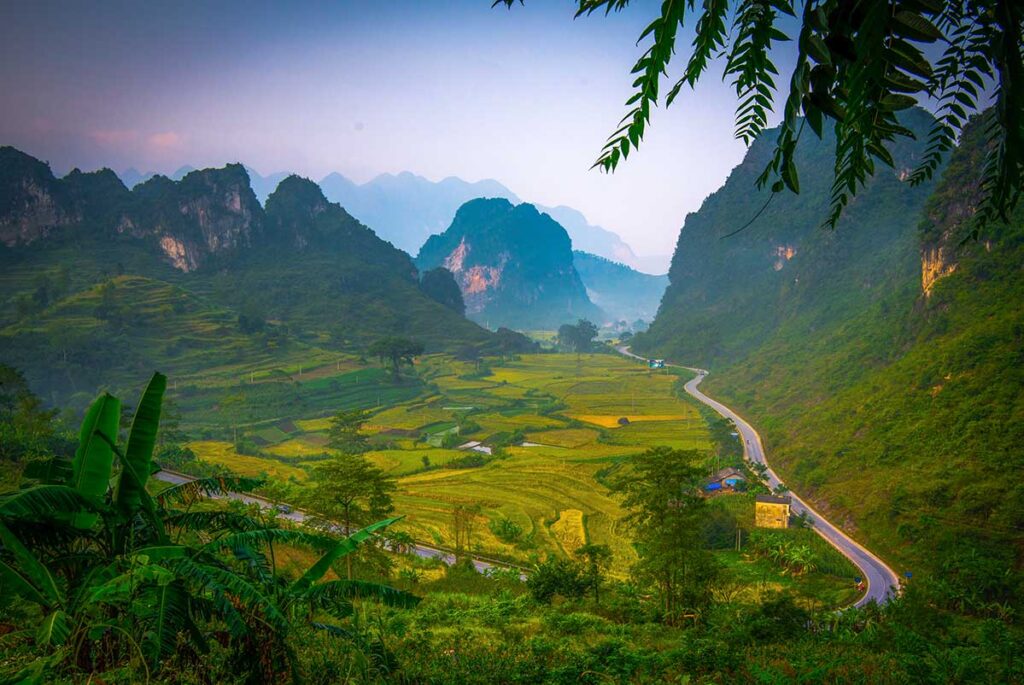
The pass itself isn’t one of Vietnam’s most dramatic, but the surrounding scenery is worth a stop. Located about 21 km from Cao Bang City along Route QL3, Ma Phuc rises to 700 meters and sits in a region with unique geological history — once an underwater volcano zone, leaving behind pillow-shaped basalt rocks. It’s a nice roadside break with photo opportunities.
3. Angel Eye Mountain (Nui Thung)

Also known as God’s Eye Mountain, this is one of the most surreal landscapes in Cao Bang. The mountain has a large circular hole through its peak and sits inside a wide valley that can flood in rainy season, creating a mirror-like lake at its base. The whole area is peaceful, with forests, rice fields, and limestone mountains. It’s becoming more known but still feels remote.
4. Thang Hen Lake
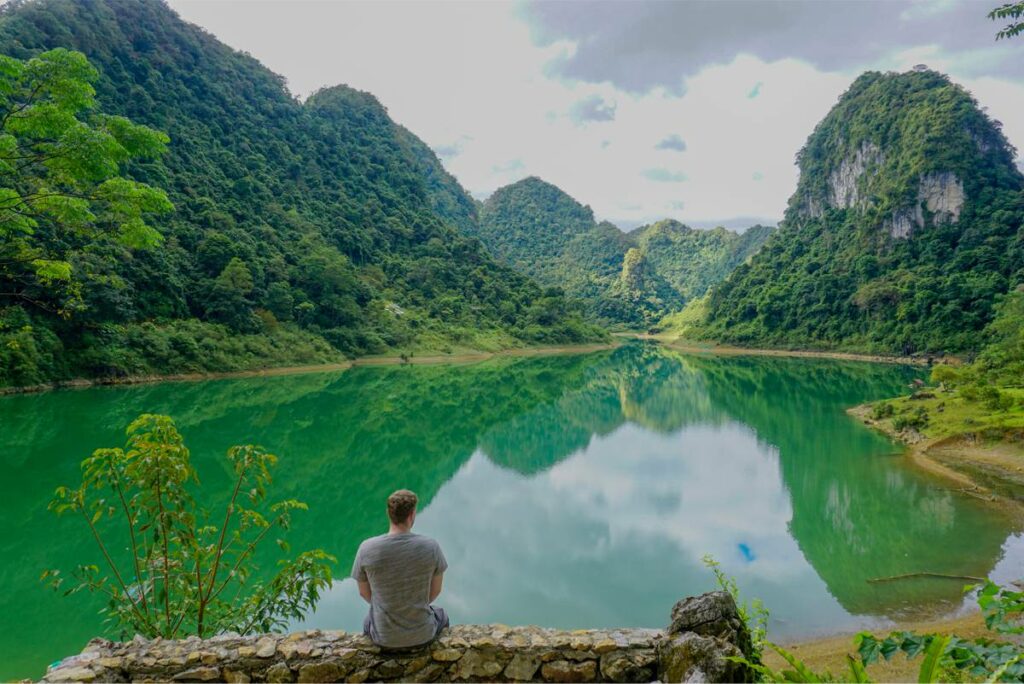
A short detour from Angel Eye Mountain brings you to this scenic lake, which is actually part of a network of lakes that change shape with the seasons. In hot weather, it’s a refreshing place to stop — some visitors enjoy activities like SUP boarding or simply relaxing by the water.
5. Trung Khanh District
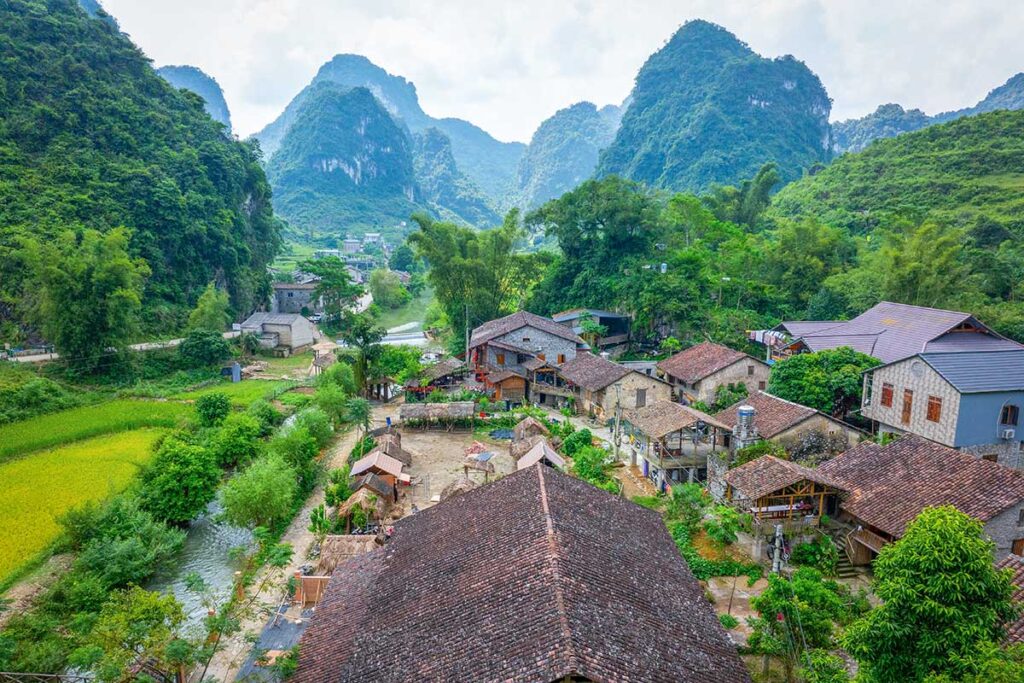
This is not a single sight, but a region — and one of the most scenic areas in the province. It includes some of the top attractions below, but is also full of quiet ethnic villages, green valleys, and the Quay Son River, which flows past rice fields and mountain backdrops. Trung Khanh is incredibly peaceful and a major reason why the Cao Bang Loop is so special.
6. Ban Gioc Waterfall
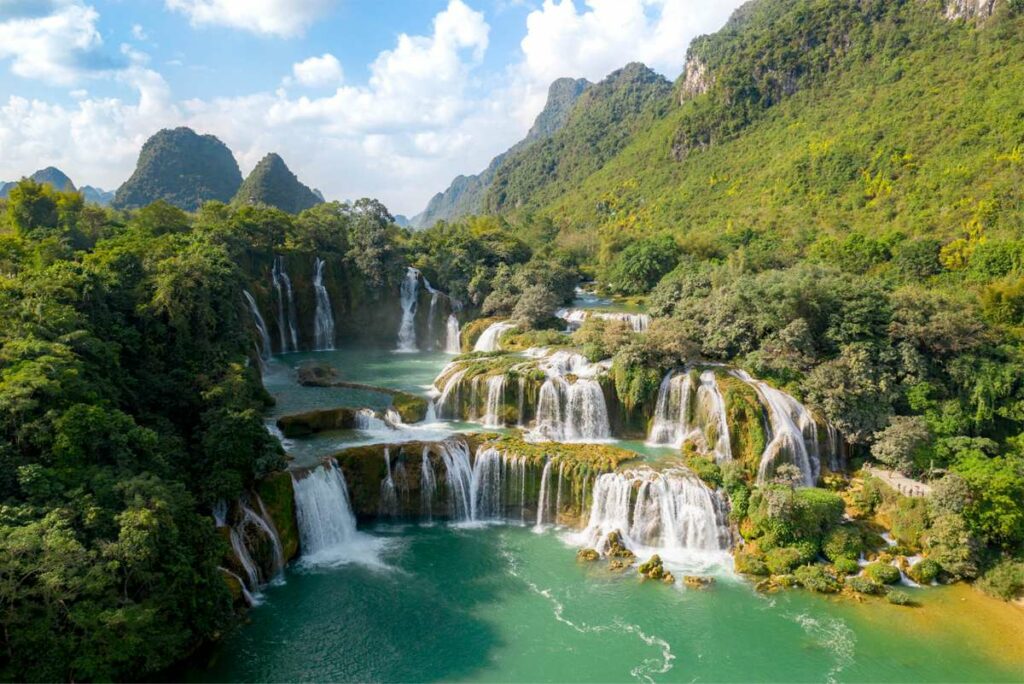
The most famous sight along the loop, Ban Gioc Waterfall is one of the largest and most beautiful in Southeast Asia, and it sits right on the border with China. You can view the falls from various angles, take a bamboo raft closer to the water, or just relax in the surrounding nature. It’s busy compared to other spots in Cao Bang — but it’s popular for a reason.
7. Phat Tich Truc Lam Ban Gioc Pagoda
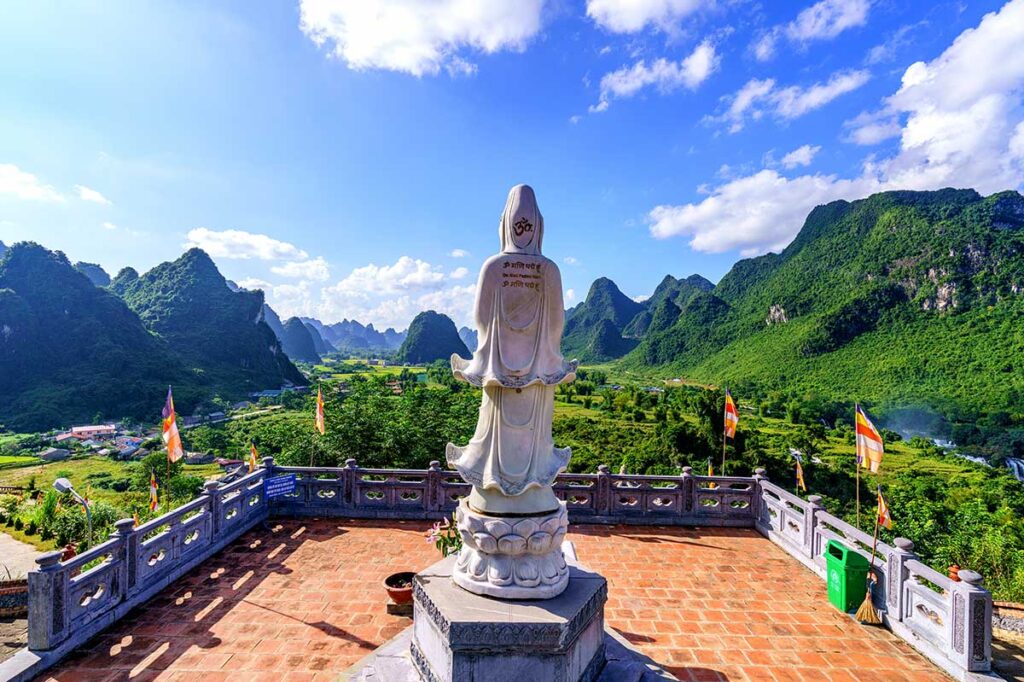
Just above Ban Gioc Waterfall, this peaceful pagoda is worth a visit if you have extra time and the weather is clear. While you can’t see the full waterfall from here, the view includes part of the falls, green rice fields, and surrounding mountains — perfect for photos or quiet reflection.
8. Nguom Ngao Cave
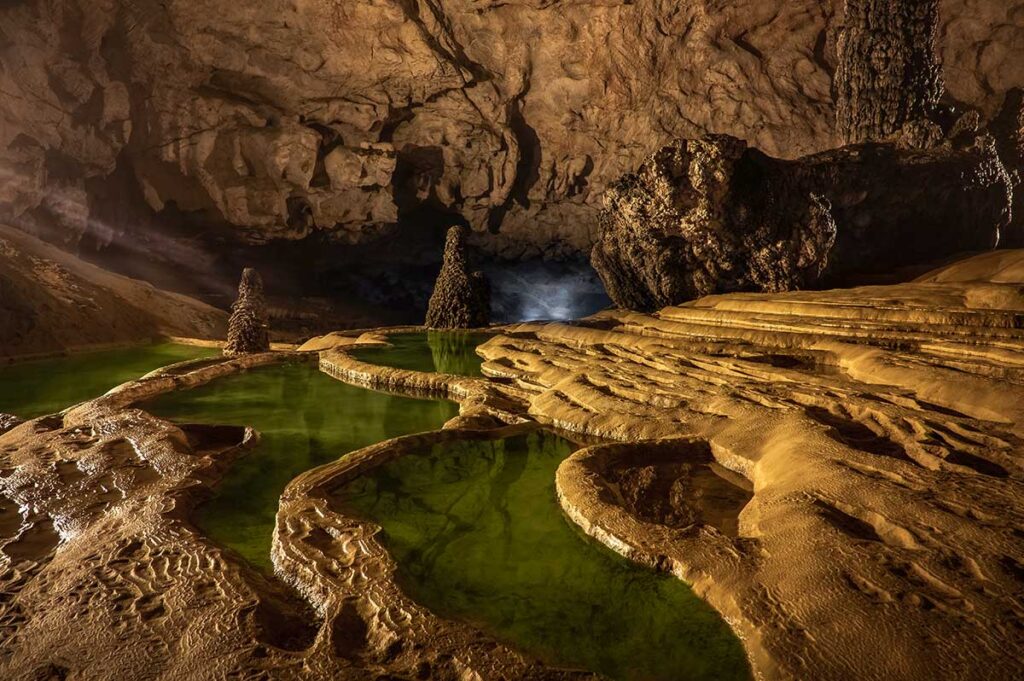
Located close to Ban Gioc, this impressive cave stretches for over 2 km, though only part is open to the public. Inside, you’ll find limestone formations, cool air, and quiet chambers — a great option to escape the heat or rain. It’s easy to combine with a visit to the waterfall.
6. Phong Nam Valley
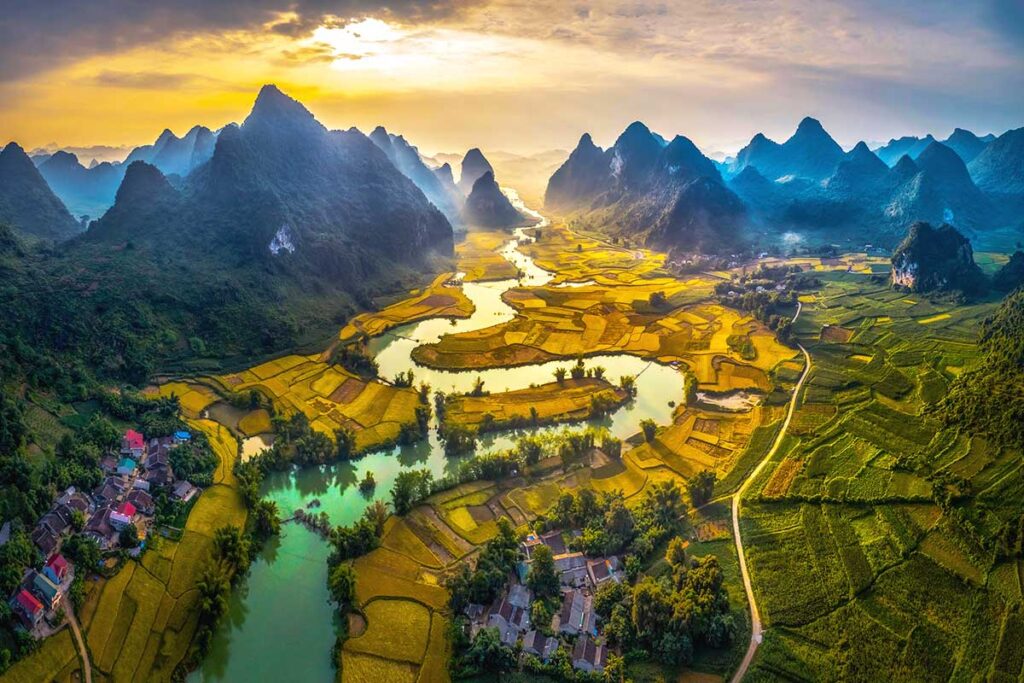
A real hidden gem just a short ride from Ban Gioc, but with almost no tourists. Phong Nam Valley feels like a scene from a fantasy movie — a wide valley surrounded by sharp limestone peaks, with rice paddies, streams, waterfalls, and small villages scattered throughout. This is one of the most peaceful and scenic places in all of Cao Bang, and a must-see stop along the loop.
Highlights along Cao Bang Eastern extension
This part of the loop doesn’t have major tourist attractions — and that’s exactly why it’s special. You come here for the mountains, quiet roads, and a real sense of remoteness. It’s a route for travelers who want to go deeper.
7. Ha Lang

Located next to Trung Khanh, Ha Lang is a quiet and untouched region with no famous sights — but endless mountain views, ethnic villages, and grassy hills. It’s rarely visited by outsiders, making it perfect for a peaceful ride or short hike. If you have time, stop at the Vinh Quy grass hills for a scenic break and panoramic views.
Highlights along Cao Bang Western loop extension
The western side of Cao Bang is the most remote part of the loop, with entire stretches of road passing through nothing but mountains, forests, and small ethnic communities. These highlights are more spread out, but the journey is just as impressive as the destinations.
8. Phja Oac National Park

A cool, forested region with misty mountain peaks and rare flora, Phja Oac is a nice contrast to the karst valleys elsewhere in the province. It’s home to some of the highest peaks in Cao Bang and a refreshing stop, especially in the hotter months.
9. Pac Po
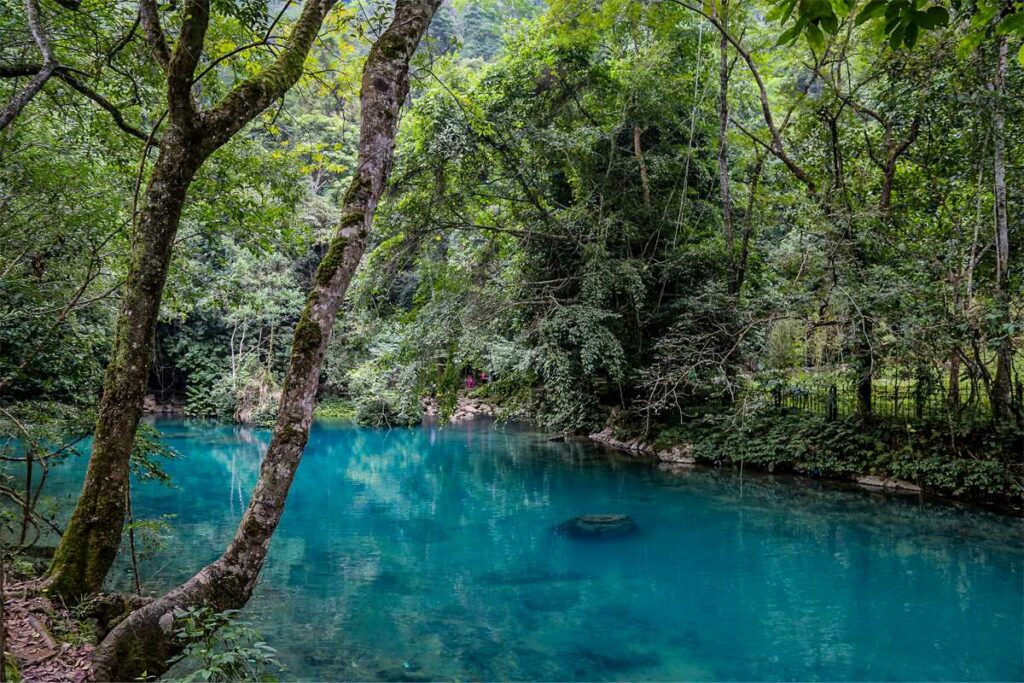
A meaningful historical site near the Chinese border, Pac Bo is where Ho Chi Minh re-entered Vietnam in 1941 after years of exile. You can visit the small cave where he lived and see the surrounding mountains and river. Even if you’re not into history, the landscape here is calm and beautiful.
10. Me Pja Pass
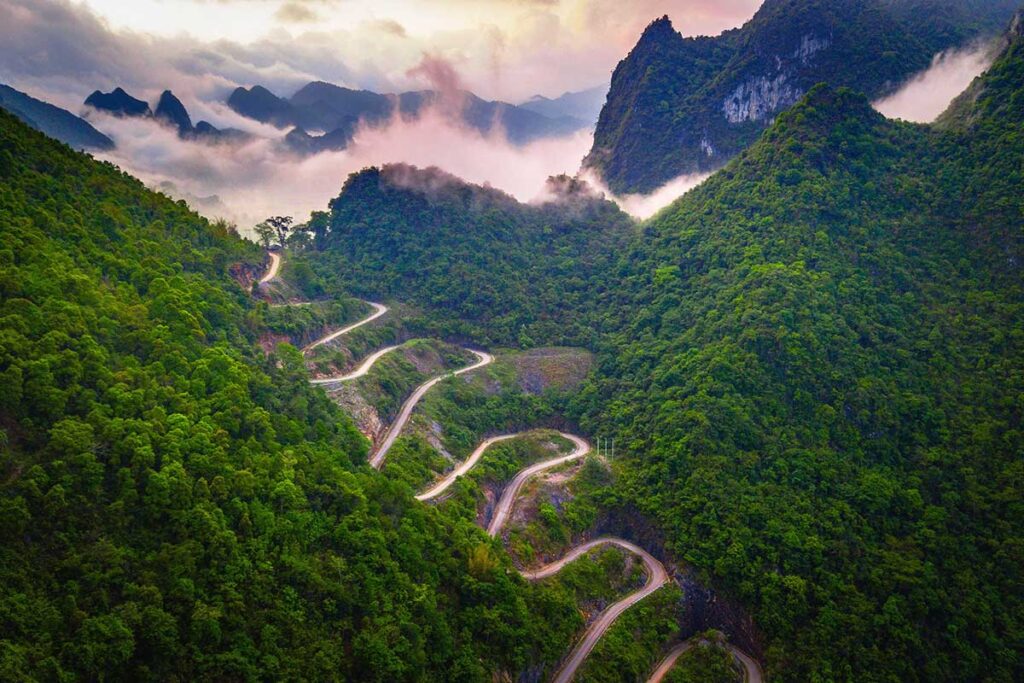
Me Pja Pass is one of the most spectacular mountain passes in northern Vietnam — with 14 sharp switchbacks carved into a cliffside. There’s a viewpoint hike above the pass that gives you a jaw-dropping look at the whole zigzag road. Me Pia is gaining attention but still feels wild and dramatic.
11. Bao Lac
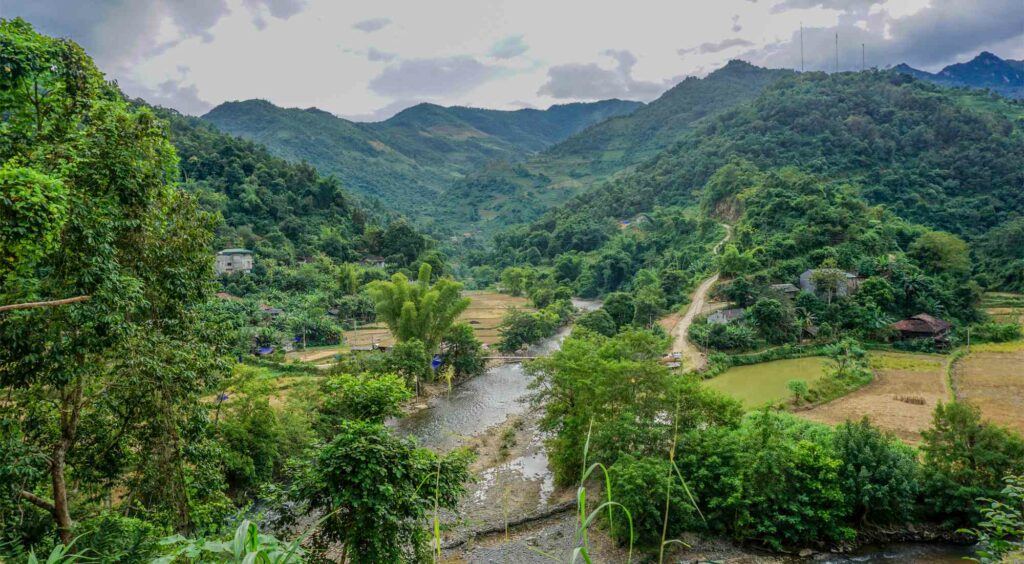
Like Trung Khanh in the east, Bao Lac is more than a single place — it’s a remote district full of ethnic diversity, highland markets, and raw mountain scenery. Me Pia Pass is located here, but the district as a whole is worth exploring. The mountains are different in shape and feeling from the rest of Cao Bang, giving the loop a bit more Ha Giang feeling if you come this way.
Best time to do the Cao Bang Loop
The best time to do the Cao Bang Loop depends on what kind of experience you’re looking for. In general, spring and autumn offer the most pleasant weather, with clear skies and comfortable temperatures — making them ideal for motorbike or outdoor travel. Winter is dry and great for driving, but can be quite cold, especially in the mountains. Summer brings lush scenery and full waterfalls, but also the highest chance of rain and heat.
Here’s a quick seasonal breakdown:
Spring (March to May)
Spring is one of the best times to travel the Cao Bang Loop. The weather is mild and dry, with temperatures ranging from 20–28°C (68–82°F) in the daytime and cooler nights in the mountains. Fields start to turn green, and the scenery is fresh after the dry winter. Visibility is usually good, and conditions are ideal for both motorbiking and hiking.
Summer (June to August)
Summer is the hottest and wettest season in Cao Bang, with daytime temperatures often above 30°C (86°F). There’s also a higher chance of rain and thunderstorms, especially in the late afternoon.
That said, this is when the landscape is at its greenest, and the Ban Gioc Waterfall is at its most powerful thanks to the rainfall. If you’re traveling by car, or don’t mind a bit of rain and humidity, summer can still be a rewarding time to go — just be prepared for changing weather.
Autumn (September to November)
Autumn is another excellent time to do the Cao Bang Loop. The rain starts to fade, the air becomes cooler, and the skies are often clear. Daytime temperatures are around 22–28°C (72–82°F) with crisp, dry air in the mountains.
This is also the rice harvest season in many valleys, which makes for stunning golden landscapes — especially in places like Phong Nam and Trung Khanh. Ideal conditions for both sightseeing and photography.
Winter (December to February)
Winter in Cao Bang is dry but cold, especially in the higher areas around Phja Oac and Me Pia Pass. Daytime temperatures can drop to 12–18°C (54–64°F), and it can feel colder in the mountains. Nights can get close to freezing.
It’s still a good time to travel if you’re going by car, or don’t mind wearing extra layers. The air is clear, and rainfall is low — making for stable travel conditions, even if the scenery isn’t as vibrant as in other seasons.
Travel tips for doing the Cao Bang Loop
The Cao Bang Loop is one of Vietnam’s most scenic and rewarding routes — but it also brings some challenges, especially in the more remote areas. Here are a few travel tips to help you prepare and get the most out of your trip.
Bring enough cash
Cash is king in Vietnam, and this is even more true in remote areas like Cao Bang. Most small hotels, homestays, restaurants, and shops do not accept cards, especially outside the Ban Gioc area. ATMs are limited once you’re outside Cao Bang City, so make sure to withdraw enough cash before starting the loop.
Prepare for mostly basic accommodations along the loop
While you can find a few nice homestays near Ban Gioc Waterfall, most accommodations along the loop — especially in the far west and east — are very basic. Expect local guesthouses or family-run homestays with limited English and amenities. It’s part of the experience, but manage your expectations if you’re used to higher comfort levels.
Eating a local restaurant and bring snacks
Cao Bang is not yet developed for tourism like Ha Giang or Sapa. You’ll mostly find local Vietnamese eateries, with no Western food and limited menus. In remote areas, some villages may not have restaurants at all. Plan your route so that mealtimes line up with larger towns, and bring extra snacks, especially if you’re vegetarian or have dietary restrictions.
Combining your Cao Bang Loop
- Lang Son Province: If you enjoy off-the-beaten-track travel, Cao Bang connects easily with nearby Lang Son. Highlights include the panoramic view from Bac Son Valley, the winding road to Mau Son Mountain, and the peaceful rural scenery of Huu Lien with grasslands and ethnic villages.
- Ha Giang Province: You can also combine the Cao Bang Loop with the famous Ha Giang Loop. Instead of looping back to Ha Giang City, continue eastward to enter Cao Bang — linking the two most scenic road trips in Vietnam into one incredible journey.
Extra tips for driving Cao Bang Loop by motorbike solo
- Get gas when you can: Some remote areas have no gas stations. Locals may sell petrol in bottles from their homes, but it’s best to refuel in towns whenever possible.
- Get a Vietnamese SIM card: For basic navigation, calling, or translation, having mobile data is very helpful.
- Download offline maps: Mobile signal can be weak or non-existent in remote valleys. Apps like Google Maps or Maps.me work well offline if downloaded in advance.
- Bring a rain cover or waterproof bag: Weather can change quickly, even in dry seasons. Always carry a way to protect your gear and yourself.
Start your days early
Distances may not look far on the map, but narrow roads, mountain passes, and photo stops can slow you down. Avoid riding in the dark, especially if you’re on a motorbike.
